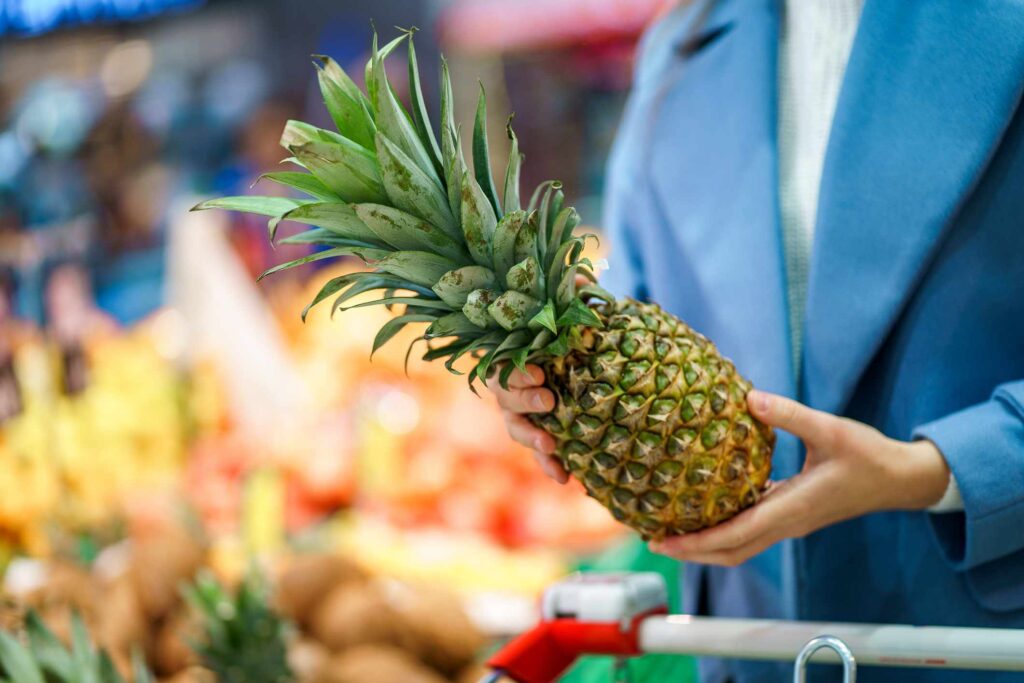Pineapple is a delicious and deeply satisfying tropical fruit—if you pick the right one. There’s nothing worse than looking forward to a juicy bite of pineapple only to realize it’s overripe or not sweet enough.
To help you avoid the disappointment of picking pineapples that taste like cardboard, we asked dietitians and food scientists for their go-to signs that the fruit will meet your expectations.
A ripe pineapple should smell sweet and fragrant at the bottom. As pineapples mature, they convert acidity into sugar, creating that iconic aroma, explains Jennifer Pallian, BSc, RD, a registered dietitian, food scientist, and recipe developer.
“No scent? It’s probably underripe and will taste tart and tough. If it smells fermented or like vinegar, it’s overripe and past its best,” said Pallian.
When picking a pineapple, check the skin. A fully golden pineapple is usually at its peak for juiciness and flavor. A mostly green one, on the other hand, might still be hard and sour, according to Pallian. Meanwhile, if it is completely yellow, this can mean it’s at its peak and should be eaten as soon as possible.
Peterson also recommends avoiding pineapples with blemishes or mold at the base. “If it’s leaking, sticky, or has white fuzz, it’s been sitting too long,” she said.
When you pick it up, a good pineapple should feel heavy for its size. That extra heft means it’s full of juice. A light pineapple might be dry inside or not fully mature, according to Pallian.
“Pick up a few of the same size pineapple,” suggested Peterson. “The heaviest one is your winner. The more weight means more juice.”
The eyes, the diamond-like patterns on the rind, also tell a story. “As the fruit ripens, the eyes flatten out. It means the texture inside is soft, juicy, and fibrous,” said Pallian. If the eyes are deep and sharp, the fruit is probably underdeveloped and will be dry and crunchy.
Pineapple is more than 85% water, making it a great choice for staying hydrated, said Pallian. But if you don’t pay attention to the eyes, you could end up with pineapple that tastes more like cardboard.
One of the most common tricks is the leaf test. Gently tug on a center leaf from the crown. If it comes out with a little resistance, the fruit is likely ripe. If it pops right out with no effort, it could be overripe. And if it barely budges, the pineapple needs more time, said Pallian.
It should have a slight give to it when you squeeze, but not feel soft or squishy, said Peterson. The general rule of thumb is firm but forgiving pineapple. Too soft means it is past its prime, she says.
“Choose a pineapple that feels like it’s asking to be eaten today, not a week from now,” says Peterson. “Pineapples don’t ripen significantly once picked. So what you see and smell is what you get.”
Pineapple is a tropical fruit bursting with flavor and juiciness. But when not selected carefully, it can taste dry, hard, and crunchy.
To pick the best pineapple in the market, you need to smell it, squeeze it, and tug at the leaves. You also should check its weightiness as well as examine its eyes and color.
If it passes this six-pronged litmus test, it’s likely you have a juicy, flavorful pineapple in your hand. Just make sure you eat it within a few days of purchasing.


